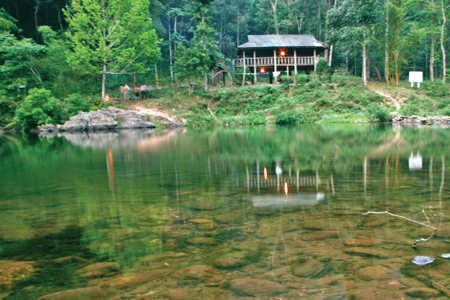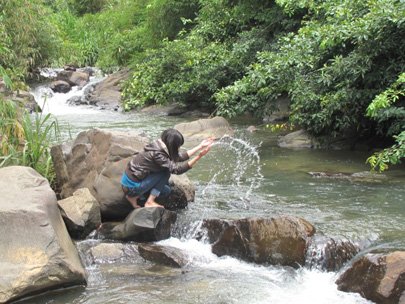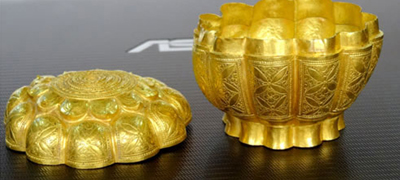Peripheral attractions - Vietnam
Published: 06/12/2012 03:54
There is something about a mountain that is sacred, maybe it is its aloofness, the fact that it stands away from the hustle and bustle of daily life, offering an ideal space for introspection, reflection and meditation. And some mountains become sacred hotspots after houses of worship are constructed on them.
Every year, the Yen Tu Mountain, where Vietnamese Zen Buddhism founder King Tran Nhan Tong (1258-1308) became enlightened, draws hundreds of thousands of pilgrims. They usually access the 1,064-meter mountain from its east side and a cable car system. But, even as Yen Tu gets all the attention it richly deserves, those willing to veer slightly off the beaten path and explore the west side of the holy mountain are in for more than a pleasant surprise –numerous pagodas, waterfalls and streams besides century-old trees are to be found along the way to the mountain top in the districts of Yen Dung, Son Dong, Luc Ngan and Luc Nam in Bac Giang Province.
Choosing Luc Nam District as the main destination for our trip to Yen Tu’s west side this time, we set off on motorbikes from Hanoi. After riding for about 100 kilometers, we reached the district’s Doi Ngo Town. From there, we followed Road 293, which was so rough that it seemed to seriously threaten the well-being of our bikes. Our first destination was Mo Stream, where we burned incense at the three temples Thuong (above), Trung (middle), and Ha (below).
Mo flows around the Huyen Dinh Mountain, and at many sections it turns into small and big waterfalls, including Thum Thum, the highest of them all. After resting for a while under a 200-year-old-plus orchid tree on the premises of the Ha Temple, we decided to check out the Thum Thum Waterfall, highly praised by those who have been there before. The waterfall was about 3.5 kilometers away, which was not a long distance, but the road was so rocky that it sapped the energy. We had to drive with intense concentration, and in this situation, a sudden downpour did not provide any relief. Soon we spotted a small creek, and a young ice-cream seller from the Cao La ethnic minority told us that there was another kilometer to reach Thum Thum. He said we could get there by walking along the creek or through the nearby forest. The kind man did not forget to warn us of leeches. Thum Thum, starting from the top of Huyen Dinh Mountain some 100 meters high, falls in four stages with each of them having its own unique attraction. At the first level, there are “bathtubs,” ponds created by the cascade and rocks. They looked so attractive that many of us of could not help but jump into them to have the cool and powerful water rejuvenate our sore muscles and dirty bodies after a long hard trip. The way to the second level was quite tricky and slippery. We had to hold hands and hold onto tree branches, carefully, so we did not slip and fall. No wonder the second level was named Tron (slippery) Waterfall. And, the third level had such clean and pure water that every small pebble on the bottom could be seen. We then crossed giant rocks and went through a forest to reach the last level. As the last waterfall was not very high, just between three and four meters, young men could try hanging on to the rocks and reached the top, completing what we called the Thum Thum obstacle course. The waterfall was named after the sound of the drum call of Tran Hung Dao (1228–1300), the supreme commander under the Tran Dynasty who repelled three Mongol invasions in the 13th century. Holy water One of the most famous “assets” of Luc Nam is the Nuoc Vang (golden water) Stream that runs along Phat Son Mountain, between 800 and 900 meters above the sea level. Many theories, both scientific and legendary, have tried to explain the unique color of the stream – similar to bee honey – which stays the same throughout the year. Scientists speculate that the color is caused by a giant coal mine in Quang Ninh Province or the disintegration and agglomeration of trees over thousands of years. Local folklore has it that the water gets its color from the sacred place from where it flows. Located on the top of the Phat Son Mountain, and not far from the origin of Nuoc Vang is the Ngoa Van Temple – a hermitage where King Tran Nhan Tong lived as an ascetic more than 700 years ago.
To see the holy stream with our own eyes, we headed to Luc Son Commune, where it is located some five kilometers from the headquarters of the local People’s Committee. Once again, the rocky road was a stiff challenge, but one well worth meeting, because you are rewarded by refreshing, transparent waters of the stream and beautiful views. We reached the 50-meter Giot Waterfall at the top of Nuoc Vang, marking our final destination for this trip, but the enjoyment was just beginning. Source: Thanhniennews |
Provide by Vietnam Travel
Peripheral attractions - Vietnam - Vietnam culture value - Vietnam culture | vietnam travel company
You can see more
- “Sac bua” singing recognised as national intangible cultural heritage
- Market Culture in Vietnam
- Hung Kings worship, source of nation's strength
- Honoring Hung Kings’ worship rituals
- Forging craft of Nung ethnic people in Cao Bang
- Foreign tourists go to Vietnam to… eat, why not?
- Lam Kinh Back to origins of the later Le Dynasty
- Perfume Pagoda pilgrimage
enews & updates
Sign up to receive breaking news as well as receive other site updates!
- Hanoi ranked top 3 cuisine in the world in 2023
- Beautiful resorts for a weekend escape close to Hanoi
- Travel trends in 2023
- In the spring, Moc Chau is covered in plum blossoms.
- The Most Wonderful Destinations In Sapa
- Top 3 Special festivals in Vietnam during Tet holiday - 2023
- 5 tourist hotspots expected to see a spike in visitors during Lunar New Year 2023
- How To Make Kitchen Cleaned
- Health benefits of lime
- Cooperation expanding between Havard University and Vietnamese universities
-
vietnam travel
http://www.vietnamtourism.org.vn " Vietnam Tourism: Vietnam Travel Guide, Culture, Travel, Entertainment, Guide, News, and...
-
Vietnam culture, culture travel
http://travel.org.vn " Vietnam culture
-
Vietnam travel, vietnam travel news, vietnam in photos
http://www.nccorp.vn " Vietnam travel, vietnam travel news, vietnam in photos
-
Vietnam tourism
http://www.vietnamtourism.org.vn " The official online information on culture, travel, entertainment, and including facts, maps,...
-
Vietnam Travel and Tourism
http://www.vietnamtourism.org.vn/ " Vietnam Travel, Entertainment, People, Agents, Company, Vietnam Tourism information.
-
Information travel online
http://www.travellive.org "Information travel online















